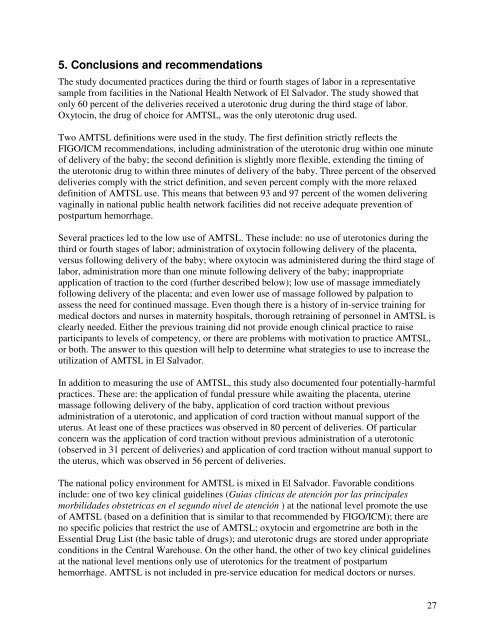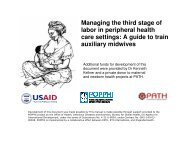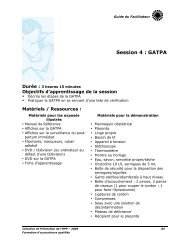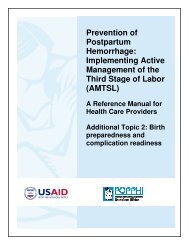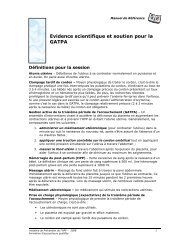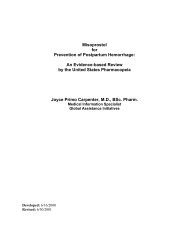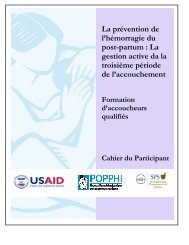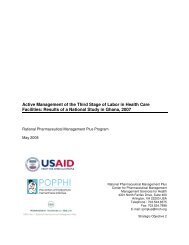El Salvador - Active Management of the Third Stage of Labor - POPPHI
El Salvador - Active Management of the Third Stage of Labor - POPPHI
El Salvador - Active Management of the Third Stage of Labor - POPPHI
You also want an ePaper? Increase the reach of your titles
YUMPU automatically turns print PDFs into web optimized ePapers that Google loves.
5. Conclusions and recommendationsThe study documented practices during <strong>the</strong> third or fourth stages <strong>of</strong> labor in a representativesample from facilities in <strong>the</strong> National Health Network <strong>of</strong> <strong>El</strong> <strong>Salvador</strong>. The study showed thatonly 60 percent <strong>of</strong> <strong>the</strong> deliveries received a uterotonic drug during <strong>the</strong> third stage <strong>of</strong> labor.Oxytocin, <strong>the</strong> drug <strong>of</strong> choice for AMTSL, was <strong>the</strong> only uterotonic drug used.Two AMTSL definitions were used in <strong>the</strong> study. The first definition strictly reflects <strong>the</strong>FIGO/ICM recommendations, including administration <strong>of</strong> <strong>the</strong> uterotonic drug within one minute<strong>of</strong> delivery <strong>of</strong> <strong>the</strong> baby; <strong>the</strong> second definition is slightly more flexible, extending <strong>the</strong> timing <strong>of</strong><strong>the</strong> uterotonic drug to within three minutes <strong>of</strong> delivery <strong>of</strong> <strong>the</strong> baby. Three percent <strong>of</strong> <strong>the</strong> observeddeliveries comply with <strong>the</strong> strict definition, and seven percent comply with <strong>the</strong> more relaxeddefinition <strong>of</strong> AMTSL use. This means that between 93 and 97 percent <strong>of</strong> <strong>the</strong> women deliveringvaginally in national public health network facilities did not receive adequate prevention <strong>of</strong>postpartum hemorrhage.Several practices led to <strong>the</strong> low use <strong>of</strong> AMTSL. These include: no use <strong>of</strong> uterotonics during <strong>the</strong>third or fourth stages <strong>of</strong> labor; administration <strong>of</strong> oxytocin following delivery <strong>of</strong> <strong>the</strong> placenta,versus following delivery <strong>of</strong> <strong>the</strong> baby; where oxytocin was administered during <strong>the</strong> third stage <strong>of</strong>labor, administration more than one minute following delivery <strong>of</strong> <strong>the</strong> baby; inappropriateapplication <strong>of</strong> traction to <strong>the</strong> cord (fur<strong>the</strong>r described below); low use <strong>of</strong> massage immediatelyfollowing delivery <strong>of</strong> <strong>the</strong> placenta; and even lower use <strong>of</strong> massage followed by palpation toassess <strong>the</strong> need for continued massage. Even though <strong>the</strong>re is a history <strong>of</strong> in-service training formedical doctors and nurses in maternity hospitals, thorough retraining <strong>of</strong> personnel in AMTSL isclearly needed. Ei<strong>the</strong>r <strong>the</strong> previous training did not provide enough clinical practice to raiseparticipants to levels <strong>of</strong> competency, or <strong>the</strong>re are problems with motivation to practice AMTSL,or both. The answer to this question will help to determine what strategies to use to increase <strong>the</strong>utilization <strong>of</strong> AMTSL in <strong>El</strong> <strong>Salvador</strong>.In addition to measuring <strong>the</strong> use <strong>of</strong> AMTSL, this study also documented four potentially-harmfulpractices. These are: <strong>the</strong> application <strong>of</strong> fundal pressure while awaiting <strong>the</strong> placenta, uterinemassage following delivery <strong>of</strong> <strong>the</strong> baby, application <strong>of</strong> cord traction without previousadministration <strong>of</strong> a uterotonic, and application <strong>of</strong> cord traction without manual support <strong>of</strong> <strong>the</strong>uterus. At least one <strong>of</strong> <strong>the</strong>se practices was observed in 80 percent <strong>of</strong> deliveries. Of particularconcern was <strong>the</strong> application <strong>of</strong> cord traction without previous administration <strong>of</strong> a uterotonic(observed in 31 percent <strong>of</strong> deliveries) and application <strong>of</strong> cord traction without manual support to<strong>the</strong> uterus, which was observed in 56 percent <strong>of</strong> deliveries.The national policy environment for AMTSL is mixed in <strong>El</strong> <strong>Salvador</strong>. Favorable conditionsinclude: one <strong>of</strong> two key clinical guidelines (Guias clinicas de atención por las principalesmorbilidades obstetricas en el segundo nivel de atención ) at <strong>the</strong> national level promote <strong>the</strong> use<strong>of</strong> AMTSL (based on a definition that is similar to that recommended by FIGO/ICM); <strong>the</strong>re areno specific policies that restrict <strong>the</strong> use <strong>of</strong> AMTSL; oxytocin and ergometrine are both in <strong>the</strong>Essential Drug List (<strong>the</strong> basic table <strong>of</strong> drugs); and uterotonic drugs are stored under appropriateconditions in <strong>the</strong> Central Warehouse. On <strong>the</strong> o<strong>the</strong>r hand, <strong>the</strong> o<strong>the</strong>r <strong>of</strong> two key clinical guidelinesat <strong>the</strong> national level mentions only use <strong>of</strong> uterotonics for <strong>the</strong> treatment <strong>of</strong> postpartumhemorrhage. AMTSL is not included in pre-service education for medical doctors or nurses.27


